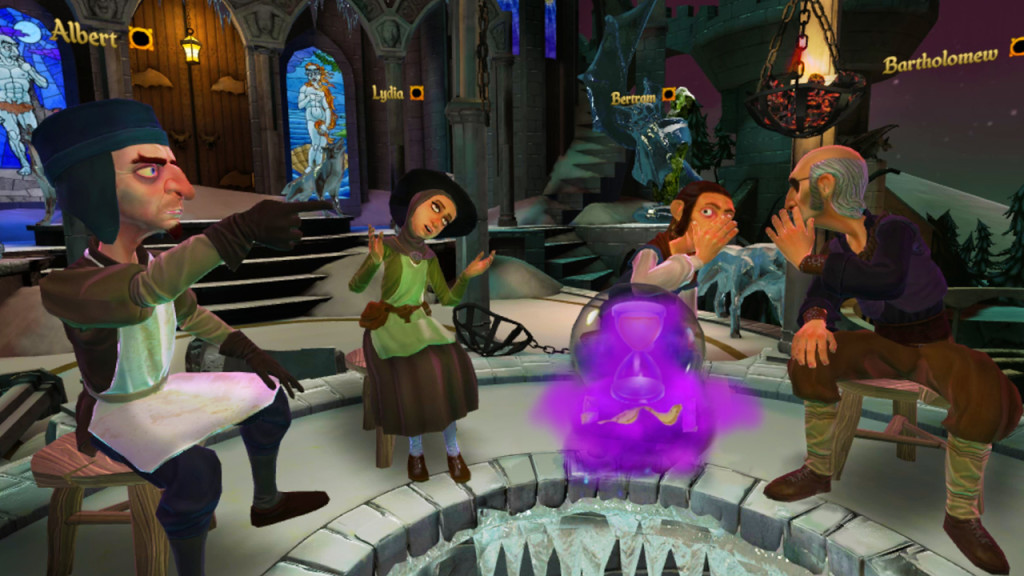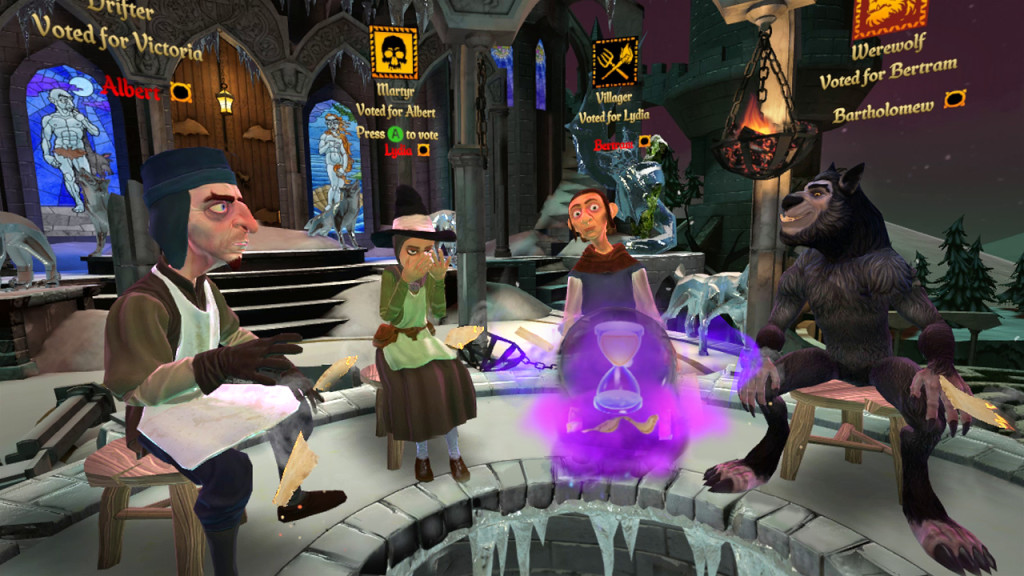While many virtual reality games and experiences focus on taking people to far-off places and worlds, Ubisoft and Red Storm Entertainment decided to use the technology to bring people closer together with the announcement of Werewolves Within. The virtual reality game, which launches this fall for platforms like the Oculus Rift and PlayStation VR, lets five-to-eight players gather around a campfire to play detective. Set in the medieval village of Gallowston, players are challenged to use their skills of persuasion and deduction to find out which among them is a werewolf. At the same time, werewolves must find ways to throw off suspicion.
The virtual reality experience is enhanced with the ability to secretly whisper to other players, and special technology that animates the avatar according to the player’s movements and voice inflections. When taken together, the social-multiplayer game feels very much like a physical social gathering.
David Votypka, senior creative director on Werewolves Within, talked to [a]listdaily about social gaming in virtual reality and how to properly detect a werewolf in your midst.
 What inspired the development of Werewolves Within?
What inspired the development of Werewolves Within?
A small team at Red Storm had been working on social multiplayer gaming for some time before we started working on it in VR. In the fall of 2014, we took one of those prototypes and got it running in VR. This had us seated across a table from each other, and when we saw the movement of the character model being driven by real human motion (as opposed to pre-made animations), we immediately felt like we were there with another human being. We had just experienced shared presence for the first time, and it was profound.
Soon after, a team of us built a prototype focused on classic social deduction-style games. I chose this direction simply because I wanted to start by leveraging an already proven social gameplay formula, so that we and others could solely evaluate the prototype based on the merits of how effective VR is as a social gaming medium. The results were very compelling, and everyone we played it with had the exact same reaction. As time went on, we felt it was worth turning this into a full VR game by creating our own version of a social deduction game, complete with unique mechanics that can only be realized with VR.
What convinced you to develop a social multiplayer game, considering Red Storm’s history with action games?
While a large part of the studio has been working on action games such as Far Cry and Tom Clancy’s The Division, a small team here had been focused on social multiplayer gaming–prior to VR–as part of an research and development mandate we agreed upon with Ubisoft HQ a couple of years ago. Our initial goal was to increase the depth and variety of social dynamics in online multiplayer gaming, and to empower players to use their social skills online.
We built a few different prototypes with original designs that largely focused on social deduction experiences. These ranged from paper prototypes, to a full-on board game, to 3D digital prototypes. They generally featured a hidden traitor or potential traitor of some sort, with gameplay that centered around building trust through cooperation, while having a risk of betrayal. We learned a lot and had some compelling social gaming come out of this work. Ultimately though, the idea of allowing players to truly use their social skills online was somewhat elusive until VR resurfaced and gave us a powerful new toolset to leverage.
Can you explain how VR is becoming an ideal social platform, and how Werewolves Within takes advantage of that?
The concept of social presence, in a digital environment, wasn’t really practical before VR. In order to feel like you are sharing the same digital environment with another person, your mind needs to be convinced that you are there, and that the character you are looking at is another human being. It’s difficult to explain until you try it for yourself, but I’ll just say that your brain can tell the difference when looking at a pre-animated character, versus one that’s being controlled by the actual movements and body language of a real person. Because of this, VR has the potential to open up all sorts of social experiences, in games and otherwise. Additional technologies are being explored such as VR headsets being able to track facial expressions, as well as tracking the eyes of the user. Social VR is already compelling, and it’s only going to get better as time goes on.
With Werewolves Within we can deliver a multiplayer video game that has its gameplay driven by verbal discussion, player personality, and social interaction. While gameplay of this type in the physical world has been around since the dawn of humanity, it is now possible and compelling in the digital space. The technology also allows us to include unique gameplay mechanics that utilize the VR hardware such as physically leaning over to whisper to the player next to you in the game, or literally standing up to perform a monologue. In digital format we can hide and share information with players in ways that aren’t possible in the physical format of social gaming, and many of the role abilities in Werewolves Within leverage this benefit.

How does the positional tracking and voice inflection technology work?
The position (and orientation) tracking is all done by the VR headset which is fed to the game. We then take this data and network it to the rest of the players which allows everyone to see where everyone else is looking. In addition, since the position of a human’s torso is largely driven by their head and neck, we are able to accurately portray where each player is leaning, i.e. whether they’re sitting upright, leaning forward, or to the side. All of these factors contribute the perception of looking at a real person.
Regarding voice inflection, hand tracking was not in the initial design or plans for the game, so what we did instead was to include automated speaking gestures that are driven by the player’s voice input. The technology actually came out of our pre-VR social prototypes, which is an algorithm that chooses speaking gestures based on various properties of the voice input that is received and analyzed in real-time. For example analyzing patterns of intensity and pitch will determine whether the avatar should play a subtle speaking gesture animation, or a more exaggerated one. Ubisoft Barcelona also built technology that analyzes the player’s voice input to create real-time lip sync animations and play logical facial expressions based on voice analysis. All of this tech helps support the believability and natural feeling of the social interactions amongst the group.
What are some of the things to keep in mind when searching out a werewolf?
Looking for long pointy nails and overly hairy hands! No, actually there are a number of strategies. For example, werewolves can use the whisper mechanic to their advantage. If two players whisper together and one of them is a werewolf, then after five seconds the werewolf player will sniff out the other player’s role. So, werewolves are generally quite inclined to whisper with others which can be something to watch for. Secondly, each townsfolk player has an ability to gain a little bit of information, and if the group shares information they gather it usually helps narrow down the possibilities of who the most likely culprits are. Assuming, of course, that the people sharing the information aren’t lying to put you off their trail!
How quickly do you think virtual reality will catch on?
I can’t really speculate on a date, but I will say that more and more people are becoming convinced that it’s not a question of if, but when. VR has already caught on for many people, namely those that have had the chance to try it and have tried quality experiences. The VR hardware manufacturers are doing great work in making compelling VR possible and empowering software developers to deliver great content, which is most definitely our goal at Red Storm and at Ubisoft.

